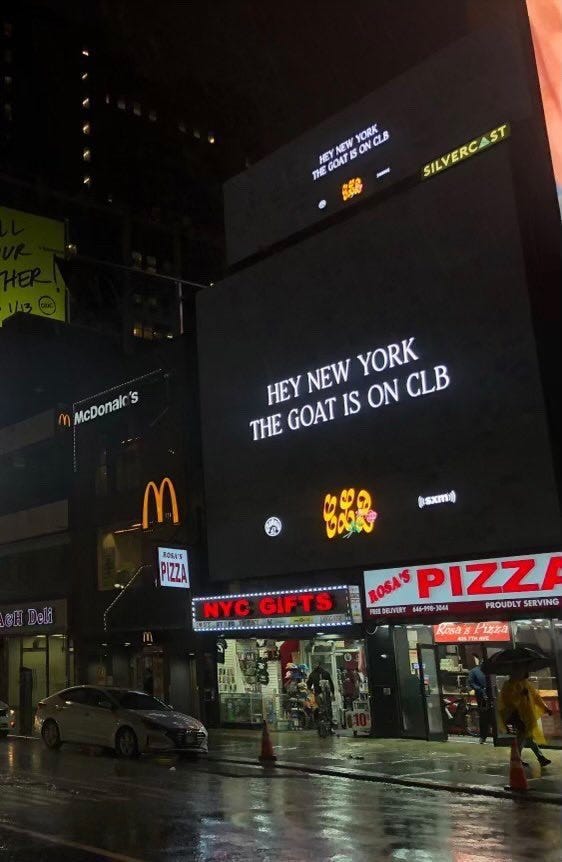Heart of the City
What Jay-Z's "The Blueprint" taught us about New York's resilience.
Today the world looks back on a day that profoundly changed history. As more kids come of age who barely remember where they were on 9/11, two decades since the date has become a moment to reflect on the terrorist attacks that remind us of both America’s vulnerability and New York’s resilience.
But amongst the social media posts where older heads recall where they were the moment they heard about the Twin Towers, harrowing photos depicting New Yorkers’ initial shock and reactions to Ground Zero—at times capturing photos of themselves with the burning buildings in the background—the date had an effect on the creative industries as well. Shows at that season’s New York Fashion Week were cancelled (a whole other article worth writing…), and back in those days, album releases still happened mostly on physical media, and they all came out on Tuesday.
That particular day marked the release of Jay-Z’s The Blueprint, arguably the album that cemented his status as the GOAT long before Drake put it on a CLB billboard.
In many ways, 9/11 focused the world’s attention to New York as a microcosm for America’s global contributions. Arguably, the greatest of what the country has brought to the table is its pop culture, and even though garage rock bands like The Strokes, art rock groups like the Yeah Yeah Yeahs, and other indie acts from New York still demanded attention from scenesters, cool kids, and the prevailing hipster stereotype that once characterized Williamsburg, Brooklyn, hip-hop was truly becoming a global movement, and of course, as Jay-Z proclaimed in the first track of The Blueprint, this album proclaimed the ruler was back.
“Jay’s confidence and lyrical skill were the record’s greatest selling point. Whatever else was going on in hip-hop in the 2000s—and it was a time of massive growth and geographic diversification,” writes Marc Richardson in The Wall Street Journal. “Jay-Z’s towering presence post-Blueprint, which included promoting influential artists like Harlem’s the Diplomats via his Roc-a-Fella label, kept New York in the conversation.”
As people reflect on date by posting a 1996 picture by photographer Atsuko Tanaka featuring the Twin Towers in the background, the irony of The Blueprint coming out on 9/11 may be lost on many people posting the pic, simply thinking the photo is a nostalgic look at a different time of the city.
In fact, Jay-Z’s relationship with the Financial District runs deeper. Plenty of Tanaka’s photos featuring the burgeoning businessman-turned-business, man were taken at Roc-a-Fella’s original offices at 17 John Street. Do a quick Google Map search to confirm where that is, and you’ll see it’s mere blocks from Ground Zero.
The Blueprint stands out far beyond its unfortunate connection to an American tragedy, but also stellar production that comes almost exclusively from Just Blaze and Kanye West, a true “no skips” album. Tracks like “Heart of the City” ring truer today, especially when Jay not only references Biggie’s track “My Downfall” in a verse, following it up with “But every time I hit the ground, I bounce up like roundball.” Meanwhile, the inimitable “Song Cry” serves as a catharsis for people processing the complicated feelings of grief, loss, and the idea of appearing strong during a time of immense sadness, which is an appropriate gauge of hip-hop’s psychological climate post-9/11.
The Blueprint laid the foundation of luxury rap, setting Jay-Z on the course from mogul to monopoly. Its blatant praise of capitalism, consumption, and chasing wealth also embodied the very thing that Al Qaeda condemned. Despite having its legacy tied to 9/11, The Blueprint still managed to sell an impressive 427,000 copies in its opening week.
It’s no surprise that Jay-Z even referenced it on “The Bounce” off his follow-up: The Blueprint 2: The Gift & The Curse, spitting: “Rumor has it The Blueprint classic / Couldn't even be stopped by Bin Laden / So September 11th marks the era forever / Of a revolutionary Jay Guevara.”
Further, The Blueprint was Jay-Z’s fourth consecutive album to reach number one on the Billboard 200 chart, and eventually went double platinum.
“Content-wise The Blueprint was symbolic of the very wealth and prosperity the World Trade Center towers were supposed to represent for the United States of America — a country whose ultimate wealth and prosperity exist almost solely for the top one percent of its population, and which also holds the title for the largest prison population in the world,” writes TheGrio. “Those who purchased Jay’s album in the midst of slow moving thick clouds of pyroclastic dust billowing around the recently imploded Twin Towers were either seeking solace from a grim reality brought on by the beginnings of a perpetual war on terror that they themselves had nothing to do with, or they were indeed doing the only thing they knew how to do in times of war and peace: consume.”






🗽
From the first Hidden article until now I've learned many new things that I've embraced and cemented into my memory. All have been a great conversation point with many of the individuals surrounding me of similar interest and even others who I can help inform as well. Im grateful for the opportunity to read great articles like this that also tell a significant story behind the hip-hop culture. This is always an important topic to touch on no matter where you're from and it's much appreciated. Rest in peace to all those that lost their lives and thank you to Jay Z for an everlasting masterpiece. Look forward to the next article!